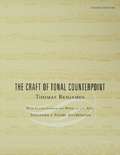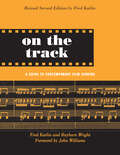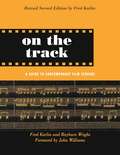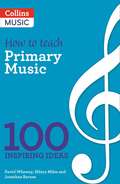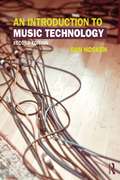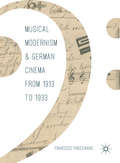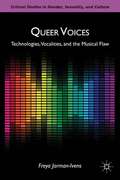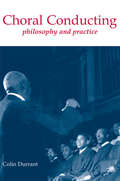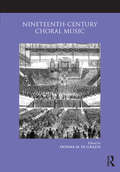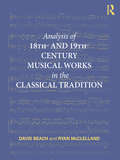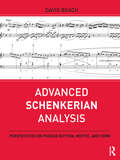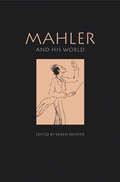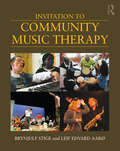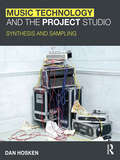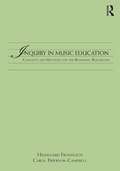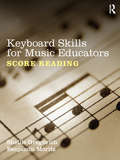- Table View
- List View
The Craft of Tonal Counterpoint
by Thomas BenjaminFirst Published in 2003. Routledge is an imprint of Taylor & Francis, an informa company.
On the Track: A Guide to Contemporary Film Scoring
by Fred Karlin Rayburn WrightOn the Track offers a comprehensive guide to scoring for film and television. Covering all styles and genres, the authors, both noted film composers, cover everything from the nuts-and-bolts of timing, cuing, and recording through balancing the composer's aesthetic vision with the needs of the film itself. Unlike other books that are aimed at the person "dreaming" of a career, this is truly a guide that can be used by everyone from students to technically sophisticated professionals. It contains over 100 interviews with noted composers, illustrating the many technical points made through the text.
On the Track: A Guide to Contemporary Film Scoring
by Fred Karlin Rayburn WrightOn the Track offers a comprehensive guide to scoring for film and television. Covering all styles and genres, the authors, both noted film composers, cover everything from the nuts-and-bolts of timing, cuing, and recording through balancing the composer's aesthetic vision with the needs of the film itself. Unlike other books that are aimed at the person "dreaming" of a career, this is truly a guide that can be used by everyone from students to technically sophisticated professionals. It contains over 100 interviews with noted composers, illustrating the many technical points made through the text.
100 Ideas For Primary Teachers: Making Musical Schools (PDF)
by David Wheway Hilary Miles Jonathan Barnes100 Ideas provides simple ideas, which are easy to implement, to make primary schools more musical. There are very few resources for primary schools which provide easy dip-in ideas on how to incorporate music within the school day and this book brings together a large number of ideas to inspire and equip teachers, and share good and innovative practice. Music doesn't have to be scary, and there are lots of ways to use music throughout the whole school, in and outside of the curriculum, and at different times of the year. These easy dip-in ideas and activities go across the spectrum, with ideas teachers can take on board easily. * Musical activities * Warm-ups and skill builders * Singing assemblies * Putting on a school musical * Simple concert performances * Inclusion * Liaising with visiting music teachers * Technology * School recordings & CDs * Composers of the week * Visual displays * After-school clubs * Greeting and goodbye songs * Songs to instruct children for activities (make a circle) * Supporting the curriculum music * Liaising with music hubs and external musicians
An Introduction to Music Technology
by Dan HoskenAn Introduction to Music Technology, Second Edition provides a clear overview of the essential elements of music technology for today’s musician. This book focuses on the topics that underlie the hardware and software in use today: Sound, Audio, MIDI, Computer Notation, and Computer- Assisted Instruction. Appendices cover necessary computer hardware and software concepts. Written for both music technology majors and non-majors, this textbook introduces fundamental principles and practices so students can learn to work with a wide range of software programs, adapt to new music technologies, and apply music technology in their performance, composition, teaching, and analysis. Features: Thorough explanations of key topics in music technology Content applicable to all software and hardware, not linked to just one piece of software or gear In-depth discussion of digital audio topics, such as sampling rates, resolutions, and file formats Explanations of standard audio plug-ins including dynamics processors, EQs, and delay based effects Coverage of synthesis and sampling in software instruments Pedagogical features, including: Further Reading sections that allow the student to delve deeper into topics of interest Suggested Activities that can be carried out with a variety of different programs Key Terms at the end of each chapter What Do I Need? Chapters covering the types of hardware and software needed in order to put together Audio and MIDI systems A companion website with links to audio examples that demonstrate various concepts, step-by-step tutorials, relevant hardware, software, and additional audio and video resources. The new edition has been fully updated to cover new technologies that have emerged since the first edition, including iOS and mobile platforms, online notation software, alternate controllers, and Open Sound Control (OSC).
An Introduction to Music Technology
by Dan HoskenAn Introduction to Music Technology, Second Edition provides a clear overview of the essential elements of music technology for today’s musician. This book focuses on the topics that underlie the hardware and software in use today: Sound, Audio, MIDI, Computer Notation, and Computer- Assisted Instruction. Appendices cover necessary computer hardware and software concepts. Written for both music technology majors and non-majors, this textbook introduces fundamental principles and practices so students can learn to work with a wide range of software programs, adapt to new music technologies, and apply music technology in their performance, composition, teaching, and analysis. Features: Thorough explanations of key topics in music technology Content applicable to all software and hardware, not linked to just one piece of software or gear In-depth discussion of digital audio topics, such as sampling rates, resolutions, and file formats Explanations of standard audio plug-ins including dynamics processors, EQs, and delay based effects Coverage of synthesis and sampling in software instruments Pedagogical features, including: Further Reading sections that allow the student to delve deeper into topics of interest Suggested Activities that can be carried out with a variety of different programs Key Terms at the end of each chapter What Do I Need? Chapters covering the types of hardware and software needed in order to put together Audio and MIDI systems A companion website with links to audio examples that demonstrate various concepts, step-by-step tutorials, relevant hardware, software, and additional audio and video resources. The new edition has been fully updated to cover new technologies that have emerged since the first edition, including iOS and mobile platforms, online notation software, alternate controllers, and Open Sound Control (OSC).
Musical Modernism and German Cinema from 1913 to 1933
by Francesco FinocchiaroThis book investigates the relationship between musical Modernism and German cinema. It paves the way for anunorthodox path of research, one which has been little explored up until now. The main figures of musical Modernism, from Alban Berg to Paul Hindemith, and from Richard Strauss to Kurt Weill, actually had a significant relationship with cinema. True, it was a complex and contradictory relationship in which cinema often emerged more as an aesthetic point of reference than an objective reality; nonetheless, the reception of the language and aesthetic of cinema had significant influence on the domain of music. Between 1913 and 1933, Modernist composers’ exploration of cinema reached such a degree of pervasiveness and consistency as to become a true aesthetic paradigm, a paradigm that sat at the very heart of the Modernist project. In this insightful volume, Finocchiaro shows that the creative confrontation with the avant-garde medium par excellence can be regarded as a vector of musical Modernism: a new aesthetic paradigm for the very process – of deliberate misinterpretation, creative revisionism, and sometimes even intentional subversion of the Classic-Romantic tradition – which realized the “dream of Otherness” of the Modernist generation.
Musical Modernism and German Cinema from 1913 to 1933
by Francesco FinocchiaroThis book investigates the relationship between musical Modernism and German cinema. It paves the way for anunorthodox path of research, one which has been little explored up until now. The main figures of musical Modernism, from Alban Berg to Paul Hindemith, and from Richard Strauss to Kurt Weill, actually had a significant relationship with cinema. True, it was a complex and contradictory relationship in which cinema often emerged more as an aesthetic point of reference than an objective reality; nonetheless, the reception of the language and aesthetic of cinema had significant influence on the domain of music. Between 1913 and 1933, Modernist composers’ exploration of cinema reached such a degree of pervasiveness and consistency as to become a true aesthetic paradigm, a paradigm that sat at the very heart of the Modernist project. In this insightful volume, Finocchiaro shows that the creative confrontation with the avant-garde medium par excellence can be regarded as a vector of musical Modernism: a new aesthetic paradigm for the very process – of deliberate misinterpretation, creative revisionism, and sometimes even intentional subversion of the Classic-Romantic tradition – which realized the “dream of Otherness” of the Modernist generation.
Queer Voices: Technologies, Vocalities, And The Musical Flaw (PDF)
by Freya Jarman-IvensThis book argues that there are some important implications of the role the voice plays in popular music when thinking about processes of identification. The central thesis is that the voice in popular music is potentially uncanny (Freud's unheimlich), and that this may invite or guard against identification by the listener.
Choral Conducting: Philosophy and Practice
by Colin DurrantChoral Conducting is a resource for singers, teachers, and choral conductors, and a college-level text for students of choral conducting. It also includes an overview of what is involved in leading a choral group and examines theories of learning and human behaviour and the history of choral music together with conductor's role. The book also discusses issues of the conductor-vocalist relationship, the mechanics of singing, rehearsal strategies, and more.
Choral Conducting: Philosophy and Practice
by Colin DurrantChoral Conducting is a resource for singers, teachers, and choral conductors, and a college-level text for students of choral conducting. It also includes an overview of what is involved in leading a choral group and examines theories of learning and human behaviour and the history of choral music together with conductor's role. The book also discusses issues of the conductor-vocalist relationship, the mechanics of singing, rehearsal strategies, and more.
Nineteenth-Century Choral Music
by Donna M. Di GraziaNineteenth-Century Choral Music is an in-depth examination of the rich repertoire of choral music and the cultural phenomenon of choral music making throughout the period. The book is divided into three main sections. The first details the attraction to choral singing and the ways it was linked to different parts of society, and to the role of choral voices in the two principal large-scale genres of the period: the symphony and opera. A second section highlights ten choral-orchestral masterworks that are a central part of the repertoire. The final section presents overview and focus chapters covering composers, repertoire (both small and larger works), and performance life in an historical context from over a dozen regions of the world: Britain and Ireland, the Czech Republic, France, Germany, Hungary, Italy, Latin America, the Philippines, Poland, Russia, Scandinavia and Finland, Spain, and the United States. This diverse collection of essays brings together the work of 25 authors, many of whom have devoted much of their scholarly lives to the composers and music discussed, giving the reader a lively and unique perspective on this significant part of nineteenth-century musical life.
Nineteenth-Century Choral Music
by Donna M. Di GraziaNineteenth-Century Choral Music is an in-depth examination of the rich repertoire of choral music and the cultural phenomenon of choral music making throughout the period. The book is divided into three main sections. The first details the attraction to choral singing and the ways it was linked to different parts of society, and to the role of choral voices in the two principal large-scale genres of the period: the symphony and opera. A second section highlights ten choral-orchestral masterworks that are a central part of the repertoire. The final section presents overview and focus chapters covering composers, repertoire (both small and larger works), and performance life in an historical context from over a dozen regions of the world: Britain and Ireland, the Czech Republic, France, Germany, Hungary, Italy, Latin America, the Philippines, Poland, Russia, Scandinavia and Finland, Spain, and the United States. This diverse collection of essays brings together the work of 25 authors, many of whom have devoted much of their scholarly lives to the composers and music discussed, giving the reader a lively and unique perspective on this significant part of nineteenth-century musical life.
Analysis of 18th- and 19th-Century Musical Works in the Classical Tradition
by David Beach Ryan McClellandAnalysis of 18th- and 19th-Century Musical Works in the Classical Tradition is a textbook for upper-level undergraduate and graduate courses in music analysis. It outlines a process of analyzing works in the Classical tradition by uncovering the construction of a piece of music—the formal, harmonic, rhythmic, and voice-leading organizations—as well as its unique features. It develops an in-depth approach that is applied to works by composers including Haydn, Mozart, Beethoven, Schubert, Schumann, and Brahms. The book begins with foundational chapters in music theory, starting with basic diatonic harmony and progressing rapidly to more advanced topics, such as phrase design, phrase expansion, and chromatic harmony. The second part contains analyses of complete musical works and movements. The text features over 150 musical examples, including numerous complete annotated scores. Suggested assignments at the end of each chapter guide students in their own musical analysis.
Analysis of 18th- and 19th-Century Musical Works in the Classical Tradition
by David Beach Ryan McClellandAnalysis of 18th- and 19th-Century Musical Works in the Classical Tradition is a textbook for upper-level undergraduate and graduate courses in music analysis. It outlines a process of analyzing works in the Classical tradition by uncovering the construction of a piece of music—the formal, harmonic, rhythmic, and voice-leading organizations—as well as its unique features. It develops an in-depth approach that is applied to works by composers including Haydn, Mozart, Beethoven, Schubert, Schumann, and Brahms. The book begins with foundational chapters in music theory, starting with basic diatonic harmony and progressing rapidly to more advanced topics, such as phrase design, phrase expansion, and chromatic harmony. The second part contains analyses of complete musical works and movements. The text features over 150 musical examples, including numerous complete annotated scores. Suggested assignments at the end of each chapter guide students in their own musical analysis.
Advanced Schenkerian Analysis: Perspectives on Phrase Rhythm, Motive, and Form
by David BeachAdvanced Schenkerian Analysis: Perspectives on Phrase Rhythm, Motive, and Form is a textbook for students with some background in Schenkerian theory. It begins with an overview of Schenker's theories, then progresses systematically from the phrase and their various combinations to longer and more complex works. Unlike other texts on this subject, Advanced Schenkerian Analysis combines the study of multi-level pitch organization with that of phrase rhythm (the interaction of phrase and hypermeter), motivic repetition at different structural levels, and form. It also contains analytic graphs of several extended movements, separate works, and songs. A separate Instructor’s Manual provides additional advice and solutions (graphs) of all recommended assignments.
Advanced Schenkerian Analysis: Perspectives on Phrase Rhythm, Motive, and Form
by David BeachAdvanced Schenkerian Analysis: Perspectives on Phrase Rhythm, Motive, and Form is a textbook for students with some background in Schenkerian theory. It begins with an overview of Schenker's theories, then progresses systematically from the phrase and their various combinations to longer and more complex works. Unlike other texts on this subject, Advanced Schenkerian Analysis combines the study of multi-level pitch organization with that of phrase rhythm (the interaction of phrase and hypermeter), motivic repetition at different structural levels, and form. It also contains analytic graphs of several extended movements, separate works, and songs. A separate Instructor’s Manual provides additional advice and solutions (graphs) of all recommended assignments.
Mahler and His World (PDF)
by Karen PainterFrom the composer's lifetime to the present day, Gustav Mahler's music has provoked extreme responses from the public and from experts. Poised between the Romantic tradition he radically renewed and the austere modernism whose exponents he inspired, Mahler was a consummate public persona and yet an impassioned artist who withdrew to his lakeside hut where he composed his vast symphonies and intimate song cycles. His advocates have produced countless studies of the composer's life and work. But they have focused on analysis internal to the compositions, along with their programmatic contexts. In this volume, musicologists and historians turn outward to examine the broader political, social, and literary changes reflected in Mahler's music. Peter Franklin takes up questions of gender, Talia Pecker Berio examines the composer's Jewish identity, and Thomas Peattie, Charles S. Maier, and Karen Painter consider, respectively, contemporary theories of memory, the theatricality of Mahler's art and fin-de-siècle politics, and the impinging confrontation with mass society. The private world of Gustav Mahler, in his songs and late works, is explored by leading Austrian musicologist Peter Revers and a German counterpart, Camilla Bork, and by the American Mahler expert Stephen Hefling. Mahler's symphonies challenged Europeans and Americans to experience music in new ways. Before his decision to move to the United States, the composer knew of the enthusiastic response from America's urban musical audiences. Mahler and His World reproduces reviews of these early performances for the first time, edited by Zoë Lang. The Mahler controversy that polarized Austrians and Germans also unfolds through a series of documents heretofore unavailable in English, edited by Painter and Bettina Varwig, and the terms of the debate are examined by Leon Botstein in the context of the late-twentieth-century Mahler revival.
Invitation to Community Music Therapy
by Brynjulf Stige Leif Edvard AarøInvitation to Community Music Therapy presents the main perspectives and principles of community music therapy as it is practiced around the world. A relatively recent development within the broader field of music therapy, community music therapy emphasizes human connectedness, health promotion, and social change. This textbook surveys the history, theory, and current practice of community music therapy to develop a comprehensive picture of the field. Along the way it takes full measure of the diverse and vibrant ways community music therapy is practiced around the globe. Including dozens of photographs and pedagogical tools such as chapter questions, textboxes, figures, key terms, and discussion topics, Invitation to Community Music Therapy is the ideal introduction to a growing area of music therapy.
Music Technology and the Project Studio: Synthesis and Sampling
by Dan HoskenMusic Technology and the Project Studio: Synthesis and Sampling provides clear explanations of synthesis and sampling techniques and how to use them effectively and creatively. Starting with analog-style synthesis as a basic model, this textbook explores in detail how messages from a MIDI controller or sequencer are used to control elements of a synthesizer to create rich, dynamic sound. Since samplers and sample players are also common in today’s software, the book explores the details of sampling and the control of sampled instruments with MIDI messages. This book is not limited to any specific software and is general enough to apply to many different software instruments. Overviews of sound and digital audio provide students with a set of common concepts used throughout the text, and "Technically Speaking" sidebars offer detailed explanations of advanced technical concepts, preparing students for future studies in sound synthesis. Music Technology and the Project Studio: Synthesis and Sampling is an ideal follow-up to the author’s An Introduction to Music Technology, although each book can be used independently. The Companion Website includes: Audio examples demonstrating synthesis and sampling techniques Interactive software that allows the reader to experiment with various synthesis techniques Guides relating the material in the book to various software synthesizers and samplers Links to relevant resources, examples, and software
Music Technology and the Project Studio: Synthesis and Sampling
by Dan HoskenMusic Technology and the Project Studio: Synthesis and Sampling provides clear explanations of synthesis and sampling techniques and how to use them effectively and creatively. Starting with analog-style synthesis as a basic model, this textbook explores in detail how messages from a MIDI controller or sequencer are used to control elements of a synthesizer to create rich, dynamic sound. Since samplers and sample players are also common in today’s software, the book explores the details of sampling and the control of sampled instruments with MIDI messages. This book is not limited to any specific software and is general enough to apply to many different software instruments. Overviews of sound and digital audio provide students with a set of common concepts used throughout the text, and "Technically Speaking" sidebars offer detailed explanations of advanced technical concepts, preparing students for future studies in sound synthesis. Music Technology and the Project Studio: Synthesis and Sampling is an ideal follow-up to the author’s An Introduction to Music Technology, although each book can be used independently. The Companion Website includes: Audio examples demonstrating synthesis and sampling techniques Interactive software that allows the reader to experiment with various synthesis techniques Guides relating the material in the book to various software synthesizers and samplers Links to relevant resources, examples, and software
Inquiry in Music Education: Concepts and Methods for the Beginning Researcher
by Hildegard Froehlich Carol Frierson-CampbellInquiry in Music Education: Concepts and Methods for the Beginning Researcher provides an introduction to research and scholarship in music education. This textbook covers topic formulation, information literacy, reading and evaluating research studies, and planning and conducting original studies within accepted guidelines, based on research conventions in music, the other arts, education, and the humanities. Electronic search tools, hands-on assignments, supplementary teaching materials and other resources are included on the companion web site (available January 2013). Skills in research and scholarship introduce students to the language and protocols by which to succeed in today’s competitive market of grant writing, arts advocacy, and public outreach as a contributing member of the community of music educators. Following the legacy begun by Rainbow and Froehlich in Research in Music Education, published in 1987, the objectives of this book are: To expand what is meant by music education and research, To help students find their niche in those definitions, and To teach tangible skills that are useful for music educators with diverse instructional goals and career aspirations.
Inquiry in Music Education: Concepts and Methods for the Beginning Researcher
by Hildegard Froehlich Carol Frierson-CampbellInquiry in Music Education: Concepts and Methods for the Beginning Researcher provides an introduction to research and scholarship in music education. This textbook covers topic formulation, information literacy, reading and evaluating research studies, and planning and conducting original studies within accepted guidelines, based on research conventions in music, the other arts, education, and the humanities. Electronic search tools, hands-on assignments, supplementary teaching materials and other resources are included on the companion web site (available January 2013). Skills in research and scholarship introduce students to the language and protocols by which to succeed in today’s competitive market of grant writing, arts advocacy, and public outreach as a contributing member of the community of music educators. Following the legacy begun by Rainbow and Froehlich in Research in Music Education, published in 1987, the objectives of this book are: To expand what is meant by music education and research, To help students find their niche in those definitions, and To teach tangible skills that are useful for music educators with diverse instructional goals and career aspirations.
Keyboard Skills for Music Educators: Score Reading
by Shellie Gregorich Benjamin MoritzKeyboard Skills for Music Educators: Score Reading is the first textbook equip future educators with the ability to play from an open score at the keyboard. Score reading can be a daunting prospect for even the most accomplished pianist, but it is a skill required of all choral and instrumental music instructors. Although most music education curricula include requirements to achieve a certain level of proficiency in open score reading, standard textbooks contain very little material devoted to developing this skill. This textbook provides a gradual and graded approach, progressing from two-part reading to four or more parts in a variety of clefs. Each chapter focuses on one grouping of voices and provides many musical examples from a broad sampling of choral and instrumental repertoire ranging from Renaissance to contemporary works.
Keyboard Skills for Music Educators: Score Reading
by Shellie Gregorich Benjamin MoritzKeyboard Skills for Music Educators: Score Reading is the first textbook equip future educators with the ability to play from an open score at the keyboard. Score reading can be a daunting prospect for even the most accomplished pianist, but it is a skill required of all choral and instrumental music instructors. Although most music education curricula include requirements to achieve a certain level of proficiency in open score reading, standard textbooks contain very little material devoted to developing this skill. This textbook provides a gradual and graded approach, progressing from two-part reading to four or more parts in a variety of clefs. Each chapter focuses on one grouping of voices and provides many musical examples from a broad sampling of choral and instrumental repertoire ranging from Renaissance to contemporary works.
